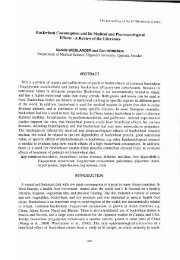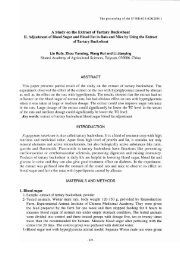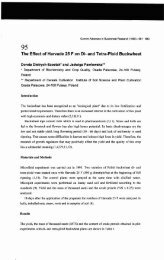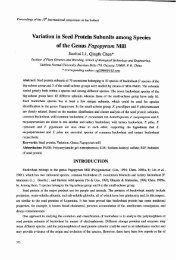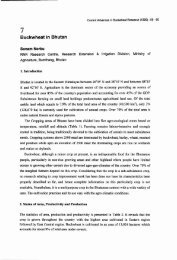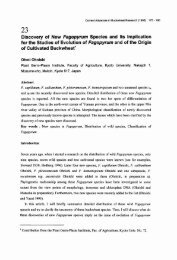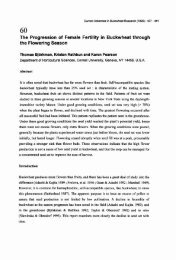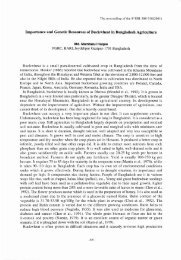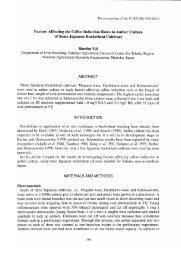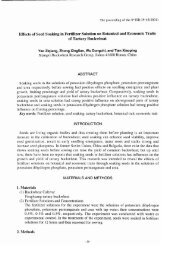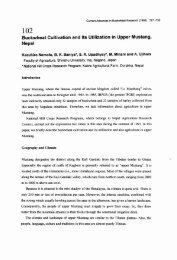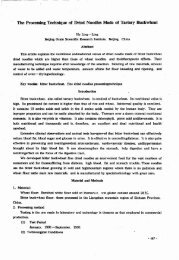35. Buckwheat in Nepal: Cultivation Practices, Research Overviews
35. Buckwheat in Nepal: Cultivation Practices, Research Overviews
35. Buckwheat in Nepal: Cultivation Practices, Research Overviews
Create successful ePaper yourself
Turn your PDF publications into a flip-book with our unique Google optimized e-Paper software.
Current Advances <strong>in</strong> <strong>Buckwheat</strong> <strong>Research</strong> (1995) : 277 - 284<br />
35<br />
<strong>Buckwheat</strong><br />
<strong>Overviews</strong>,<br />
<strong>in</strong> <strong>Nepal</strong>:<br />
Scope and<br />
<strong>Cultivation</strong><br />
Strategy<br />
<strong>Practices</strong>,<br />
<strong>Research</strong><br />
R. P. Uprety<br />
National Hill Crops <strong>Research</strong> Program, Post Box No. 1336, IDRC, Khumaltar,<br />
Kathmandu, <strong>Nepal</strong><br />
Abstract<br />
Both buckwheat species (Fagopyrum esculentum Moench and F. tataricum Geartn.) are<br />
cultivated <strong>in</strong> <strong>Nepal</strong>. It is the major summer crop and staple food <strong>in</strong> high hills. Tataricum type is<br />
more common <strong>in</strong> colder arcas where common buckwheat can not be grown. There is high<br />
potentiality of common buckwheat <strong>in</strong> Terai and Inner Terai where it best fits <strong>in</strong> Rice<br />
<strong>Buckwheat</strong>-Maize (one year) rotation.<br />
HCRP at present has 495 accessions of buckwheat which <strong>in</strong>clude common and tataricum<br />
type from local and exotic sources. Relatively wide adaptability have been found is tataricum<br />
type than <strong>in</strong> common buckwheat. GF-ll 0 (bitter showed comparatively better performance <strong>in</strong><br />
all environment. However none of the genotypes of tataricum produced significantly higher<br />
yield than local <strong>in</strong> all locations. In case ofcommon buckwheat GF-209 (778 kg / ha.) produced<br />
significantly higher yield than local at lumla. Local landrace (1986 kg / ha.) was the vest at<br />
Marpha but GF-209 was at par with it. Canadian l<strong>in</strong>e GF-5063 (1045 kg / ha.) was found best at<br />
Kabre however IR-13, GF-209 and GF-5194 were also at par and seems to be promis<strong>in</strong>g.<br />
1. Introduction<br />
Both cultivated species of buckwheat viz. Fagopyrum esculentum Moench and Fagopyrum<br />
tataricum Geartn. have been cultivated <strong>in</strong> <strong>Nepal</strong> s<strong>in</strong>ce time immemorial. Common buckwheat is<br />
found cultivated throughout the country and bitter buckwheat is more common <strong>in</strong> the hilly areas<br />
and have been found cultivated upto 3800 metre amsl, where one can not f<strong>in</strong>d common<br />
buckwheat. The wild buckwheat species reported are F. dibotryis and F. cymosum.<br />
Though there is no official statistics available however, Regrni 1982 rported 9000 hectare<br />
under buckwheat cultivation <strong>in</strong> <strong>Nepal</strong>. The estimated area and productivity of buckwheat<br />
accord<strong>in</strong>g LRMP 1985 was 43000 ha. and 540 kg / ha. respectively.<br />
<strong>Buckwheat</strong> has unique importance <strong>in</strong> high altitude areas adjo<strong>in</strong><strong>in</strong>g Himalayas <strong>in</strong> terms of<br />
distribution, cultivation and uses. It is one of the staple food and constitute one-third of total
278<br />
diet <strong>in</strong> high hill. However <strong>in</strong> midhills, tatary buckwheat is a poor men's food and preparation<br />
from common buckwheat (Fulaura and th<strong>in</strong> pancake) are luxurious items for snacks.<br />
1.1. High Hills (above 2000 metre)<br />
<strong>Buckwheat</strong> is a major summer crop of higher elevation. At higher parts of hill only tatary<br />
buckwheat is grown. The crop is grown <strong>in</strong> barley-buckwheat rotation <strong>in</strong> lower parts and only a<br />
s<strong>in</strong>gle crop of barley or buckwheat <strong>in</strong> higher parts (above 3000 metre). To scape from the<br />
volunteer plants comm<strong>in</strong>g <strong>in</strong> the field farmers usualy grow buckwheat <strong>in</strong> alternate year.<br />
Farmers plant buckwheat if prosomillet is damaged at early stage, so buckwheat has prom<strong>in</strong>ant<br />
role <strong>in</strong> production stabilization and to susta<strong>in</strong> the hill farm<strong>in</strong>g. Thus, buckwheat forms a<br />
dom<strong>in</strong>at<strong>in</strong>g role <strong>in</strong> the cropp<strong>in</strong>g system and is unlikely to be completely replaced by any other<br />
crops. It supplies 1 / 3 offood requirement <strong>in</strong> high hill and is consumed either as bread or <strong>in</strong> the<br />
form ofthick porridge. <strong>Buckwheat</strong> pancake from common type are popular <strong>in</strong> the restaurant of<br />
Mustang, Manang and Solukhumbu. Generally, the flour of bitter type is mixed with barley<br />
flour or f<strong>in</strong>gemillent flour to prepare porridge. <strong>Buckwheat</strong> food is considered nutritious and<br />
long last<strong>in</strong>g, and old farmers have perception that bitter type is still healthier than sweet type.<br />
1.2. Mid Hill (1000-2000 metre amsl)<br />
<strong>Buckwheat</strong> <strong>in</strong> mid hill is grown both <strong>in</strong> autumn and spr<strong>in</strong>g season as a catch crop. It is an<br />
important crop <strong>in</strong> the marg<strong>in</strong>al land where farmers like to grow it rather than leav<strong>in</strong>g the field<br />
fallow. Tatary buckwheat is more common <strong>in</strong> spr<strong>in</strong>g season <strong>in</strong> the land with excess poor soil<br />
fertility or <strong>in</strong> the marg<strong>in</strong>al/range land brought <strong>in</strong>to new cultivation. Farmers have perception<br />
that buckwheat provides some food security as a catch crop when the ma<strong>in</strong> crop like maize fails<br />
due to some hazards. The straw ofbuckwheat is a source offodder to the livestock which is one<br />
ofthe major <strong>in</strong>dispensable and <strong>in</strong>seperable component ofhill farm<strong>in</strong>g and it be<strong>in</strong>g the source of<br />
farm yard manure has got the prom<strong>in</strong>ent role to susta<strong>in</strong> the farm productivity. Thus, buckwheat<br />
has tremendous role <strong>in</strong> the susta<strong>in</strong>ability of hill farm<strong>in</strong>g. Rich people do not eat tatary<br />
buckwheat however thick porridge prepared by mix<strong>in</strong>g with the flour of f<strong>in</strong>germillet is a<br />
common food of poor as well as lowercast people. Food items from sweet buckwheat is<br />
considered luxurious. Fulaura is a small ball prepared from th<strong>in</strong> flour paste that is mostly<br />
cooked <strong>in</strong> hot pool of vegetable oil. Pancake is another common preparation from th<strong>in</strong> paste of<br />
common buckwheat, usually g<strong>in</strong>ger and common salt is added to make it more testy and both<br />
preparations are used as snacks. Tender leaves and shoots are used as green vegetables. It is<br />
belived that bitter buckwheat has some medic<strong>in</strong>al value and food items from it is healthier than<br />
from sweet one.
279<br />
1.3. Below 1000 Metre Amsl<br />
In this part ofthe country buckwheat follow rice and is grown as a catch crop. Though the crop<br />
is sporadic across Terai from east to west, it is more common <strong>in</strong> Jhapa (extreme east) and<br />
Chitwan (<strong>in</strong>ner terai). There is much fluctuation <strong>in</strong> the buckwheat area which is due to the<br />
variation <strong>in</strong> market price generally governed by Indian bus<strong>in</strong>ess men. There is no market of<br />
tatary buckwheat and neither any body consume it <strong>in</strong> Terai so tatary buckwheat is not cultivated<br />
<strong>in</strong> this region.<br />
<strong>Buckwheat</strong> <strong>in</strong> Terai has to compete with oil seed crops ma<strong>in</strong>ly. Brassica campestris var.<br />
Toria and Brassica campestris var. Dichotoma. However, still major area is left fallow after<br />
rice. Statistics shows that about 0.2 million ha. of land is left fallow <strong>in</strong> Terai after rice. So,<br />
majority of this fallow land can be exploited for buckwheat cultivation, however this needs<br />
assured market and acceptable technology.<br />
2. <strong>Research</strong> <strong>Overviews</strong><br />
2.1. Germplasm Collection and Evaluation<br />
Hill Crops <strong>Research</strong> Program has 495 accessions of buckwheat from various sources. Out of<br />
these 185 accessions are Fagopyrum tataricum and rest are F. esculentum. These accessions<br />
also <strong>in</strong>cludes the collection from Japanese team. Collected accessions are from diversified<br />
agroecological environments rang<strong>in</strong>g from 246 to 3870 metre ams!. HCRP has been able to<br />
ma<strong>in</strong>ta<strong>in</strong> 307 accessions of Sweet buckwheat by rejuv<strong>in</strong>at<strong>in</strong>g them <strong>in</strong> alternate year under<br />
controlled condition by us<strong>in</strong>g net and <strong>in</strong>sert<strong>in</strong>g honey bee for poll<strong>in</strong>ation. Exotic gennplasms<br />
from Canada (207), Japan (21), India (15), Yugoslavia (15) and Russia (7), has also been<br />
received and ma<strong>in</strong>ta<strong>in</strong>ed <strong>in</strong> the Central Agricultural Botany Division.<br />
2.2. Varietal Improvement<br />
Systematic breed<strong>in</strong>g programme has not yet been started perta<strong>in</strong><strong>in</strong>g to buckwheat varietal<br />
improvement work. It is because the crop ranks third <strong>in</strong> the prority order out of four mandate<br />
crops (F<strong>in</strong>gennillet, barley, buckwheat and gra<strong>in</strong> amaranth) of Hill Crops <strong>Research</strong> Programme<br />
and moreover scientists work<strong>in</strong>g <strong>in</strong> HCRP are to be properly tra<strong>in</strong>ed <strong>in</strong> the breed<strong>in</strong>g pr<strong>in</strong>ciple.<br />
Nevertheless, HCRP is cont<strong>in</strong>u<strong>in</strong>g follow<strong>in</strong>g activities as <strong>in</strong>itiation for buckwheat varietal<br />
improvement.<br />
2.2.1. Observation Nursery<br />
The nursery <strong>in</strong>cludes both exotic and local sources of common and tataricum type and planted<br />
<strong>in</strong> diverse agro-ecological environment Le. Rampur, Narpha, Kabre and khumaltar (Rang<strong>in</strong>g<br />
From about 200 metre to 2450 metre altitude). Better perform<strong>in</strong>g henolypes from various
280<br />
stations were selected for advance yield Irial. Table I shows that none of the genotype was<br />
competant to local at Marpha. In Kabre, local bitter yielded highest than all the test entries and<br />
Acc# 2230-1 and IR-13 were the most promis<strong>in</strong>g among the common buckwheat genotypes.<br />
Shkilovsky and Skorospely performed better under Khumaltar condition. In case of Rampur<br />
Acc# 2178 and Acc# 2237 were the best. Table I also shows that there is no common best<br />
perform<strong>in</strong>g genotype for all location and higher the altitude more the yield.<br />
Table I. Ten best yield<strong>in</strong>g out of48 buckwheat genotypes from advanced observation<br />
nursery <strong>in</strong> 1993.<br />
Gra<strong>in</strong> Yield kg / ha<br />
S. Genotypes / Cultivars Rampur Marpha Khumaltar Kabre<br />
No. 200m. 2450 m. 1350 m. 1740 m.<br />
I. IR-13 1400 2400<br />
2. Local (Bitter) 600 2770 530 3000<br />
3. Acc.# 2230-1 840 2450<br />
4. Acc.# 2199-2 2380<br />
5. Acc.# 2203-1 1330 2130<br />
6. BOLLODA 1590 1940<br />
7. Acc.# 2192-1 1960<br />
8. Acc.# 0491 1830<br />
9. Acc.# 0485 620 2200<br />
10. Acc.# 2178 1600 1850<br />
11. Acc.# 2237 1600 1300<br />
12. Acc.# 0486 1500 1000<br />
13. GF- 5137 1500<br />
14. Manor 1400<br />
15. Acc.# 2224 1200<br />
16. Acc.# 2236 1300<br />
17. Acc.# 2250 1250<br />
18. Acc.# 0491-2 1300 1530<br />
19. Local Sweet 300 3452 1540 750<br />
20. Acc.# 2193 1770<br />
21. Acc.# 3849-1 930<br />
22. Acc.# 6515 830<br />
23. Acc.# 2244 720<br />
24. # 85624 1630<br />
25. Acc.# 0491-1 1420<br />
26. Acc.# 2247 1490<br />
27. SKOROSPELY 1880<br />
28. SHKILOVSKY 2150<br />
29. MOHAZULUR 1760<br />
2.2.2. Coord<strong>in</strong>ated Varietal Trial (Bitter)<br />
Three years mean data given <strong>in</strong> Table 2 shows that yield differences among the genotype was<br />
not significant <strong>in</strong> all the location. Nevertheless Acc# 2223 and GF-212 were found<br />
comparatively better for Jumla condition and Acc# 2234, GF-216 and GF-II0 for Marpha area.
281<br />
Similarly genotype Acc# 2227 and GF-II0 were promis<strong>in</strong>g at Kabre.<br />
In general plants were taller at Kabre and Jumla than at Marpha. Days to maturity varied<br />
significantly among the genotypes both at Jumla and Kabre however it was not significant at<br />
Marpha.<br />
Table 2. <strong>Buckwheat</strong> Coord<strong>in</strong>ated Varietal (Bitter) Mean of 1992 to 1994.<br />
S. Gra<strong>in</strong> yield kg / ha Plant height em Maturity days<br />
No. Genotypes A B C A B C A B C<br />
I. GF-11O 1376 1210 1511 89 71 95 79 83 84<br />
2. GF-216 1327 1225 1316 81 60 88 77 79 83<br />
3. GF-212 1484 I I 19 1263 87 67 91 77 76 79<br />
4. Aee.# 2223 1477 1182 1506 89 65 92 79 83 81<br />
5. Aee.# 2230 1053 1174 1286 81 66 89 79 83 84<br />
6. Aee.# 2227 1182 1140 1610 77 61 103 80 82 81<br />
7. Aee.# 2234 1195 1422 1262 83 71 88 79 80 83<br />
8. Kabre Bitter 1299 1120 1299 80 62 88 77 83 80<br />
9. Local Bitter 1126 1040 1380 72 57 84 78 78 80<br />
CV% 31.0 40.0 33.1 16.2 15.6 15.4 1.9 3.5<br />
Genotype NS NS NS NS NS NS * NS **<br />
LSD (0.05) 465 608 433 13.3 1.8 6.4 2.7<br />
Note: A =Jumla ; B =Marpha ; C =Kahre.<br />
2.2.3. Coord<strong>in</strong>ated Varietal Trial on Common <strong>Buckwheat</strong><br />
Except local check plant hight of all genotype was highest at Kabre followed by Jumla and<br />
Marpha. It should be noted that local check was tallest (98 cm) at Marpha which <strong>in</strong>dicates that<br />
the agroclimatic condition ofMarpha was quite peculiar and local landraces grown by farmers ;<br />
which is the outcome of natural and/or fanner's selection s<strong>in</strong>ce decades or even centuries; has<br />
been found quite suitable for Marpha area. As buckwheat straw is used for fodder to the<br />
livestock, obviously preference goes to the taller genotype and significance ofbuckwheat straw<br />
as fodder is still more ant higher elevation.<br />
At Jumla, GF-209 was taller (105 em) than local check (90 cm) and seems to be a potential<br />
candidate for that area. The hight of all other genotypes was less than local check. In case of<br />
Kabre also GF-209 was the tallest (III em). Genotypes GF-5274, GF-5063 and GF-5006 were<br />
also found taller than local check (87 em).<br />
Variation <strong>in</strong> days to maturity was m<strong>in</strong>imum at Jumla (71-79 days) where GF-209 was the<br />
most late (79 days) and GF-5194 and GF-5233 were earliest (71 days), local check be<strong>in</strong>g<br />
<strong>in</strong>tennediate <strong>in</strong> maturity (74 days).<br />
Among the common buckwheat genotypes tested <strong>in</strong> different locations (Table 3) GF-209<br />
showed wide adaptability with highest gra<strong>in</strong> yield at Jumla (778 kg / ha), second highest at
282<br />
Marpha (1514 kg / ha) and fourth at Kabre (934 kg / ha) ; however, except at Jumla the yield<br />
difference was not significant with local check. At Jumla genotype no. 85628 also yield (675 kg<br />
/ ha) more than local check (529 kg / ha) but the difference was not significant.<br />
Table 3. Sweet <strong>Buckwheat</strong> Coord<strong>in</strong>ated Varietal Mean of 1992 to 1994.<br />
S. Gra<strong>in</strong> yield Kg I ha Plant Height em Maturity days<br />
No. Genotypes A B C A B C A B C<br />
I. GF-5289 411 1223 827 73 51 81 72 65 66<br />
2. GF-5099 326 539 704 71 44 81 73 66 66<br />
3. GF-5194 327 525 944 71 47 78 71 65 61<br />
4. GF-0209 778 1514 934 105 81 111 79 83 74<br />
5. GF-5006 209 556 840 84 82 99 76 74 71<br />
6. GF-5063 221 801 1045 71 46 91 72 66 71<br />
7. # 85628 675 418 726 69 45 82 72 65 64<br />
8. GF-5233 209 438 378 67 46 72 71 68 63<br />
9. # 85603 331 776 809 70 50 77 72 66 61<br />
10. GF-5274 534 660 785 85 67 101 76 74 75<br />
11. IR-13 469 1146 998 77 50 84 75 68 68<br />
12. Local Sweet 529 1986 689 90 98 87 74 90 69<br />
CV% 46.5 61.9 36.4 2.7 12.8 11.3 10.2 4.7 9.8<br />
Genotype •• •• •• •• •• •• •• •• ••<br />
LSD (0.05) 226 518 273 9.2 2.3 2.8 6.2<br />
Note: A=Jumla ; B=Marpha ; C=Kabre.<br />
Under Marpha condition local check was the highest yielder (1986 kg / ha) but at par with<br />
GF-209. Rest ofthe cultivars at Marpha performed comparatively poor.<br />
In case of Kabre GF-5063 (From Canada) was the highest yielder (1045 kg / ha) however it<br />
was at par with IR-13, GF-5l94, GF-5289, GF-5274, No.85603 and GF-5006. The yield<br />
variation among the genotypes was highest at Marpha and lowest at Kabre.<br />
2.2.4. Random Mat<strong>in</strong>g Population<br />
To acquire population with broad genetic base, eight best genotypes were planted <strong>in</strong> bulk.<br />
Individual plants selected from such population was aga<strong>in</strong> bulked for further plant<strong>in</strong>g. Four<br />
cycle of such broad base population has been completed and HCRP is plann<strong>in</strong>g to plant this<br />
population <strong>in</strong> different adverse agroecological environment and select <strong>in</strong>dividual plants and<br />
ma<strong>in</strong>ta<strong>in</strong> <strong>in</strong> isolation for the purpose ofdevelop<strong>in</strong>g new variety for particular environment.<br />
3. Scope and Strategy<br />
In case of high hills like Mustang where buckwheat is a major summer crop there is still<br />
potatiality to <strong>in</strong>crease its production and productivity which can contribute significantly to meet
283<br />
the food demand of that area where transport of food gra<strong>in</strong> from other parts the country is too<br />
expensive. Moreover lots oftourists are trek<strong>in</strong>g every year <strong>in</strong> Mustang area along Kali Gandaki<br />
river and pancake prepared from common buckwheat is the most favourable item among the<br />
tourists. So, common buckwheat also has high potantiality to attract tourist.<br />
<strong>Buckwheat</strong> <strong>in</strong> mid hills has very high significance to stabilize the production for it is grown<br />
<strong>in</strong> autumn where f<strong>in</strong>germillet could not be cultivated and <strong>in</strong> spr<strong>in</strong>g where wheat could not be<br />
grown and such lands are generally too poor and otherwise such lands would have been left<br />
fallow / under utilized. So, generation of technology <strong>in</strong> terms of variety and management<br />
practices could contribute considerably <strong>in</strong> buckwheat production and thus susta<strong>in</strong> the hill<br />
fann<strong>in</strong>g.<br />
The situation of Terai is different, where formers can get very easy crop of buckwheat after<br />
rice. <strong>Buckwheat</strong> is gett<strong>in</strong>g popularity <strong>in</strong> Chitwan (Central <strong>in</strong>ner Terai) and Jhapa (Far eastern<br />
Terai) area. If government can provide assured market, buckwheat area can be <strong>in</strong>creased<br />
rapidly; however productivity can only be <strong>in</strong>creased with the development of high yield<strong>in</strong>g<br />
variety and better management practices. The potantial buckwheat area <strong>in</strong> Terai even without<br />
disturb<strong>in</strong>g the present cropp<strong>in</strong>g pattern is as follows:<br />
Crop<br />
Area <strong>in</strong> ha<br />
Paddy 884820 Summer crop<br />
Wheat 333640 W<strong>in</strong>ter crops<br />
Lentil 163790<br />
Chickpea 24920<br />
Oil seed 134150<br />
Source: Agricultural Statistics of<strong>Nepal</strong>, 1992/1993.<br />
The area gap between summer crop (paddy) and all w<strong>in</strong>ter crops (wheat, lentil, chickpea and<br />
oilseeds) is almost 228320 ha. which is left fallow and thus is the potantial buckwheat area <strong>in</strong><br />
Terai.<br />
Moreover buckwheat has high export potantiality. Its use <strong>in</strong> baby food <strong>in</strong>dustry, noodle<br />
<strong>in</strong>dustry and mak<strong>in</strong>g sweets can not be underestimated however it needs a strong and stable<br />
government policy which can br<strong>in</strong>g significant positive change <strong>in</strong> fanners economy.<br />
HCRP is basically plann<strong>in</strong>g to develop manpower first. Varietal development and<br />
management practices will be generally done foe specific environment. Experience have shown<br />
that exotic materials or materials developed <strong>in</strong> one environment does not perform well <strong>in</strong> other<br />
environment. For example, none of the varieties from other areas were competant with local at
284<br />
Marpha. However endeavour will also be cont<strong>in</strong>ue to develop broad base population with wide<br />
adoptability.<br />
Maximum exploitation of locallandraces by collection, evaluation, selection and their use <strong>in</strong><br />
breed<strong>in</strong>g program are to be cont<strong>in</strong>ued.<br />
Studies on management practices, i.e. use of compost / commercial fertilizers, time of<br />
sow<strong>in</strong>g, seed rate, weed<strong>in</strong>g and irrigation will be done for various agroecological environment.<br />
A strong collaboration approach will be taken with national and <strong>in</strong>ternational <strong>in</strong>stitutions<br />
like IAAS Rampur, Tribhuban University, DOAD, IPGRI and Agri-food Diversification<br />
<strong>Research</strong> Centre at Morden, Canada.<br />
A strong <strong>in</strong>creas<strong>in</strong>g l<strong>in</strong>kage with NGOs and INGOs are to be stabilized for the dissem<strong>in</strong>ation<br />
ofimproved technology.<br />
References<br />
1. Adhikary, B.R. ; K.C., Gov<strong>in</strong>da; Dongol, D.M.S.; Pant, T.N. (1994) : <strong>Buckwheat</strong> <strong>in</strong> <strong>Nepal</strong>,<br />
Importance, Utilization and Farm<strong>in</strong>g System From Socio-economic Context. National Hill<br />
Crops <strong>Research</strong> Program. International Development <strong>Research</strong> Centre.<br />
2. ASD (Agricultural Statistics Division, Agricultural Statistics of <strong>Nepal</strong> 1992 / 93. MOA,<br />
Agricultural Statistics Division.<br />
3. Baniya, B.K. ; Riley, K.W. ; Dongol, D.M.S. ; Sherchand K.K. 1992. Characterization of<br />
<strong>Nepal</strong>ese Hill Crops Landraces. National Hill Crops <strong>Research</strong> Programme.<br />
4. LRMP (Land Resource Mapp<strong>in</strong>g Project), 1985. Economic Roport, His Majesty's<br />
Government of<strong>Nepal</strong> and Government ofCanada Kent<strong>in</strong>g Earth Science Limited.<br />
5. NHCRP (National Hill Crops <strong>Research</strong> Programme) 1994. Annual Report No.5 (1992 /<br />
1993). National Hill Crops <strong>Research</strong> Programme. <strong>Nepal</strong> Agricultural <strong>Research</strong> Council.<br />
6. Regmi, K.R., Sherchand, K.K., Riley, K.W. (1989) : National and International <strong>Buckwheat</strong><br />
(Fagopyrum sp.). Observation Nurseries Paper presented at Summer Hill Crops Work<strong>in</strong>g<br />
Group Meet<strong>in</strong>g, Rampur January 20, 1989.<br />
7. Regmi, P.P. (1982); An Introduction to <strong>Nepal</strong>ese Food Plants. Royal <strong>Nepal</strong> Academy, <strong>Nepal</strong>.




